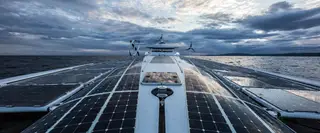In Jules Verne's novel, "The Mysterious Island," published in 1874, the book’s protagonist, Cyrus Harding, states that "water will one day be employed as fuel, and that the hydrogen and oxygen which constitute it, used singly or together, will furnish an inexhaustible source of heat and light.” Water, says Harding, will be decomposed, “undoubtedly by electricity”, into hydrogen and oxygen.
Although many of Jules Verne's reflections remain in the wonderful realm of fantasy, this is not the case with hydrogen: the hydrogen hour has arrived. Today, the fundamental role that hydrogen will play in the global energy mix, from the perspective of a sustainable development model that reduces the effects of climate change, is absolutely clear. I am convinced that hydrogen will be one of the cornerstones of energy transformation and transport and industry decarbonisation. It will enable the large-scale integration of renewable energies and their storage. And it will integrate energy distribution between sectors and regions, opening up a new world of admirable possibilities. The potential is immense, but there are still challenges ahead that must be overcome before the deployment of this large-scale energy source.
There is very little hydrogen in its pure state on planet Earth, since it is generally found coupled with other elements, which means that its extraction is compulsory. The extraction process implies energy consumption, with 95% of the hydrogen produced in an industrial way being obtained using fossil fuels, especially natural gas, with CO2 emission. The production of hydrogen in a competitive way as a source of clean energy, through electrolysis, requires the process to be improved in order to lower its costs.
There are other obstacles. Under normal pressure conditions, hydrogen occupies a large volume, which limits its storage and transport capacity. In this context, the challenges of using hydrogen as an energy source entail technological development to facilitate its compression, storage and transport.
Even in the short term, however, hydrogen can play a very important role in sustainable mobility. The automobile industry is at the forefront of this transformation. As some automobile models are already a commercial reality available in selected markets, many other brands have joined this movement and are developing and testing a set of light and heavy, hydrogen powered vehicles.
The latest technological developments present encouraging results in terms of vehicle autonomy and performance, revealing a very similar road behaviour to that of combustion engine powered cars.
In the European context, alongside electric mobility projects, a number of other hydrogen mobility projects are also underway to expand the supply network and the respective public and private vehicle fleets. The most prominent are Hydrogen Mobility Europe, ZEFER, JIVE and H2 Mobility.
It should be noted that there are various paths to sustainable mobility. Battery-powered electric vehicle technologies will coexist with fuel cell automobiles. Investment in technological research and development, as well as in the infrastructures, must therefore be transversal.
The various technologies are, at the moment, both concurrent and complementary. Public policies should, therefore, promote the creation of an environment that allows the development of the different technological solutions in a transversal way, in healthy competition.
Galp, as an integrated energy company focused on mobility, has invested in the deployment of all these alternatives, in a complementarity logic, which has allowed Portugal to remain at the forefront in access to cleaner energy sources associated with mobility, and linked major European networks through, for example, our network in Spain.
We deployed a national GPL-Auto network, which we also made available in Spain, which we hope to double by making use of this more economical and environmentally friendly energy resource.
We are doing the same for vehicular natural gas (VNG), an essential energy source for the decarbonisation of heavy road transport, which is currently in the early stages of deployment. In this case, the distribution network, which is still without generalised geographical coverage, already allows for a seamless connection with France.
We are still at the forefront of electric mobility, pioneering at the European level in the installation of the first, fast electric charging point. Today we provide a network that allows us to pass through Portugal from the north to the south. We believe in the sustainable development of the electrical supply market and we are also expanding and designing its architecture.
As far as hydrogen is concerned, we are still in the embryonic stage in defining the minimum support network essential for starting up this kind of mobility in Portugal, but we couldn’t help ourselves from being at the forefront of this global trend.
We are focused on the future and aware of the importance and responsibility that we have in Portugal's energy transition.
Jules Verne was indeed an unparalleled visionary.




